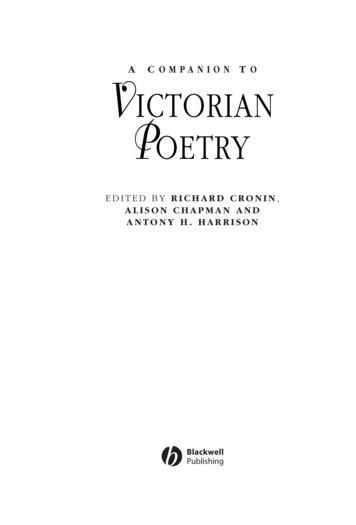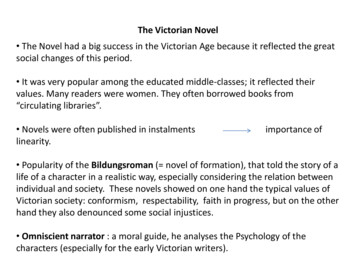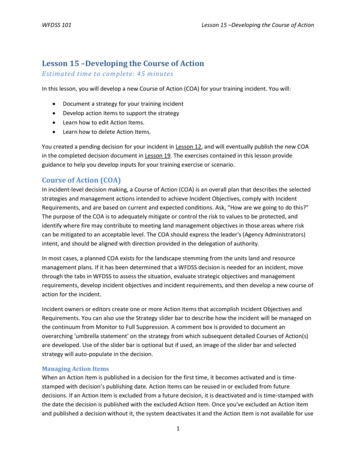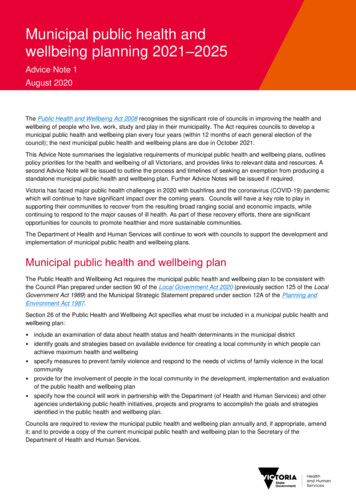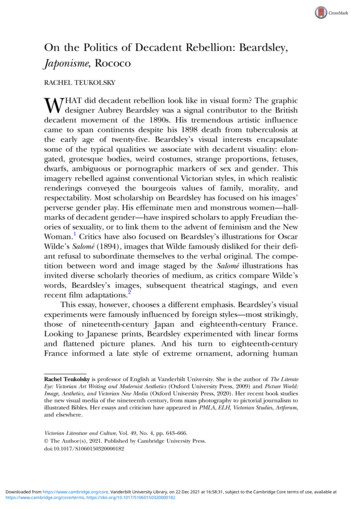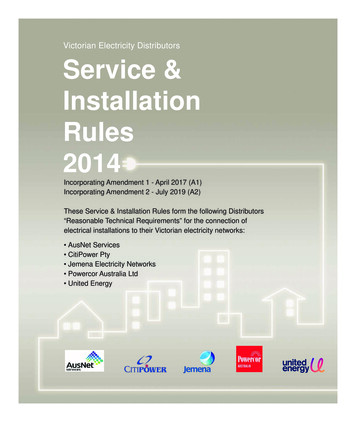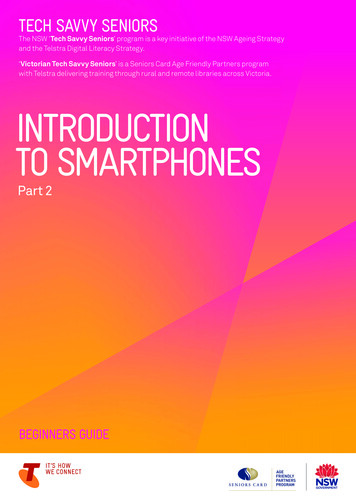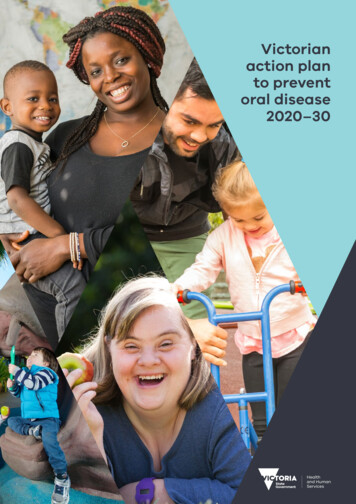
Transcription
Victorianaction planto preventoral disease2020–30
Minister’s forewordOral health is important for overall health and wellbeing. Whilethere have been significant improvements over the past 30years, there is still evidence of poor oral health among manyVictorians. Oral disease causes pain and discomfort. It is amongthe most prevalent diseases in our community and also one ofthe most costly health conditions to treat; yet it is one of the mostpreventable.Acknowledgement of Aboriginal VictoriaThe Victorian Government proudly acknowledges Victoria’s Aboriginal communities andtheir rich culture and pays respect to their Elders past and present. We acknowledgeAboriginal people as Australia’s first peoples and as the Traditional Owners andcustodians of the land and water on which we live, work and play. We recognise andvalue the ongoing contribution of Aboriginal people and communities to Victorianlife and how this enriches our society more broadly. We embrace the spirit of selfdetermination and reconciliation, working towards equality of outcomes and ensuringan equitable voice.Victorian Aboriginal communities and peoples are culturally diverse, with rich andvaried heritages and histories both pre and post-invasion. The impacts of colonisation– while having devastating effects on the traditional life of Aboriginal Nations – havenot diminished Aboriginal people’s connection to country, culture or community.Aboriginal Nations continue to strengthen and grow with the resurgence of language,lore and cultural knowledge. These rich and varied histories need to be understoodand acknowledged by all Victorians, to truly understand the resilience and strength ofprevious generations, as well as the history of the fight for survival, justice and countrythat has taken place across Victoria and around Australia.As we work together to ensure Victorian Aboriginal communities continue to thrive, thegovernment acknowledges the invaluable contributions of generations of Aboriginalwarriors that have come before us, who have fought tirelessly for the rights of theirpeople and communities towards Aboriginal self-determination. We are now honouredto be part of that vision.To receive this publication in an accessible format, email Community Based HealthPolicy and Programs AACServdev@dhhs.vic.gov.au Authorised and published by the Victorian Government, 1 Treasury Place, Melbourne. State of Victoria, Department of Health and Human Services, March 2020.Except where otherwise indicated, the images in this publication show models and illustrative settingsonly, and do not necessarily depict actual services, facilities or recipients of services.This publication may contain images of deceased Aboriginal and Torres Strait Islander peoples. Wherethe term ‘Aboriginal’ is used it refers to both Aboriginal and Torres Strait Islander people. Indigenous isretained when it is part of the title of a report, program or quotation.ISBN 978-1-76069-427-2 (Print)ISBN 978-1-76069-428-9 (pdf, online, MS word)Available at Victorian action plan to prevent oral disease https://www2.health.vic.gov.au/ (1803018)This plan sets out a vision to achieve good oral health for allVictorians by 2030 and to reduce the gap in oral health for people who are at higherrisk of oral disease.Oral disease is a key marker of disadvantage. Communities that are disproportionatelyaffected by poor oral health include people on low incomes, dependent older people,homeless people, some Aboriginal people, people in rural areas, people with a disabilityand people from culturally diverse backgrounds, particularly refugees.This year the Victorian Government has invested more into public dental care than everbefore. The School Dental Program will provide free dental examinations and follow-uptreatment for all children at government primary and secondary schools across Victoria.The 321.9 million initiative will make it easier for children to access dental care withSmile Squad dental vans visiting all public schools and providing students with a freedental pack each year to promote ongoing oral health. The initiative will save familiesaround 400 a year per child in dental costs as well as the inconvenience of takingtime off work for appointments. This new investment will reduce wait times for otherVictorians seeking public dental treatment, as the children who would otherwise betreated through the public dental scheme will now receive their care at school.The Victorian Government is proud to be investing in the oral health of children toprovide a good foundation for lifelong oral health, which will ensure that they are bestplaced for education, work and adult life.As well as dramatically expanding public provision of free dental care, we will maintaina focus on preventive care and oral health promotion to reduce the social, physical andeconomic burden of oral ill-health in the community.This action plan is based on extensive consultation coordinated by Dental HealthServices Victoria. I would like to thank members of Dental Health Services Victoria’sPopulation Health Committee and staff from community dental agencies who wereamong the more than 550 people participating in consultation forums.Victoria is building on a strong foundation of innovative and effective oral healthinitiatives and partnerships.I am pleased to release the Victorian action plan to prevent oral disease 2020–30.Together we have created a plan to improve oral health and reduce inequalities.I invite you to join me in working to achieve excellent oral health for all Victorians.The Hon Jenny MikakosMinister for Health
ContentsMinister’s forewordiIntroduction1The burden of oral disease2What we currently do4The 2020–30 action plan6Populations and settings 6Outcomes for 2030 6Priority 1: Improve the oral health of childrenPriority actionsPriority 2: Promote healthy environmentsPriority actionsPriority 3: Improve oral health literacyPriority actionsPriority 4: Improve oral health promotion, screening,early detection and prevention servicesPriority actions99111113131515Next steps: towards 203016Monitoring and review 16iii
IntroductionThe Victorian Government recognises that oral health is important to a person’soverall general health and wellbeing and is committed to improving the oral health ofVictorians, particularly children.A healthy mouth enables people to eat, speak and socialise without pain, discomfort orembarrassment.This plan sets out a vision to achieve good oral health for all Victorians by 2030, with afocus on reducing the gap in oral health for people who are at higher risk of oral disease.There have been significant improvements in oral health over the last 20 to 30 years,however there is still evidence of poor oral health among many Victorians.Oral diseases can cause pain and discomfort and negatively affect general healthand quality of life. Poor oral health has been associated with cardiovascular disease,diabetes, respiratory diseases, stroke, adverse pregnancy outcomes, stomach ulcers,oral cancers and obesity. The impact of poor oral health can also create a financialburden for individuals and within the broader health system.In preparing this strategy, Dental Health Services Victoria and the Department of Healthand Human Services consulted with more than 550 people across six consultationworkshops. Participants included members from Dental Health Services Victoria’sPopulation Health Committee; oral health staff from community dental agencies;and consumers and stakeholders from the health, early childhood, education, socialservices and local government sectors. Their input informs every aspect of this whole-ofgovernment strategy for Victoria.1
The burden of oral diseaseThe burden of oral disease comes from four main conditions: tooth decay, gum disease,oral cancer and oral trauma. Oral diseases are among the most common and costlyhealth problems experienced by Victorians.Tooth decay is the most prevalent disease in Victoria. Dental conditions are the highestcause of all potentially preventable hospitalisations in children 0–9 years, predominantlybecause of tooth decay. Gum disease is the fifth most common health problem andmore than 200 Victorians die of oral cancer each year.ChildrenAlmost half of all children aged five to 10 years have signs of tooth decay. About 37 percent of tooth decay in high-risk preschoolers is early stage disease. This can be reversedthrough preventive treatment such as fluoride varnish programs.There is considerable inequality in the distribution of oral disease, with some groups ofchildren more likely to have advanced tooth decay than the general population.Advanced tooth decay is more prevalent in children with: a parent who has ahealth care card1.8x43%51%14of all children aged5–10 yearshave signs oftooth decayof adults aged55–74 yearsare affected bygum diseaseoral cancer casesare diagnosedeach weekon averageMain causesMain causesMain causesSugar in foodsand drinksPlaque on gummargins of teethLack of preventiveeffects of fluoride andplaque on teethSmoking and diabetesLifestyle exposuressuch as tobacco,alcohol and humanpapillomavirus (HPV)infectionBroader socialdeterminants ofhealthBroader socialdeterminants ofhealth an Aboriginalbackground1.9x families who do notspeak English at home2.1xAdultsMore than 90 per cent of adults are affected by tooth decay, with one in three (32 percent) experiencing untreated tooth decay. The 2011–12 Victorian Population HealthSurvey found that: fair or poor self-rated oral health is associated with lower educational levels, highor very high psychological distress levels, physical inactivity, not meeting fruit andvegetable consumption guidelines, smoking, and fair or poor self-reported generalhealth in women, fair or poor self-rated oral health is associated with obesity and diabetes,while in men it is associated with not being in the labour force, having a long-term riskof alcohol-related harm and being underweight there is also a tendency for people on lower incomes to have poor dental visitingpatterns, with cost being a barrier.Older adultsOlder people experience high levels of oral disease which are associated with generalhealth problems such as diabetes, changes in diet, increased use of medication, and thebreakdown of heavily restored teeth. Poor oral health makes it difficult to eat a nutritiousdiet. There are high levels of oral disease in residential aged care facilities and in thegeneral community. Seniors have higher levels of oral disease than younger people. Thisis a particular problem for those who are receiving Commonwealth support at home orin residential aged care facilities.2Victorian action plan to prevent oral disease 2020–303
What we currently doIn Victoria, we are building from a strong foundation of innovative and effective oralhealth initiatives and partnerships in Victoria. There are many examples of successfulprograms and leadership, some of which are highlighted below.Healthy Families Healthy SmilesThis program aims to improve the oral health of young children, theirfamilies and pregnant women by building the knowledge and skills ofhealth and early childhood professionals to promote oral health.Under the program, more than 3,000 professionals, including midwives,maternal child health nurses, early parenting practitioners, Aboriginalhealth staff, early childhood educators and supported playgroupfacilitators, have been trained to promote oral health.Smiles 4 MilesThis program works in partnership with community health services toimprove the oral health behaviours of preschoolers, their families andearly childhood staff. Smiles 4 Miles promotes three key messages:drink well, eat well and clean well. It is affiliated with the AchievementProgram, which supports the development of healthy environments.In 2019, 730 services are participating in Smiles 4 Miles, reaching morethan 45,800 children across Victoria.Water fluoridationCommunity water fluoridation is the most effective population-wideintervention to prevent tooth decay. Majority of Victorians living inMetropolitan Melbourne have access to water fluoridation. However,there are still many Victorians living in rural and regional areaswithout access to this important public health initiative. Since 2013–14, five water fluoridation plants have been built giving more than76,000 people across 14 towns access to fluoridated drinking water.Supporting every smileIn collaboration with disability sector partners, Dental Health ServicesVictoria has developed an online package to promote good oralhealth in disability services.Supporting every smile shows disability service providers ways toincorporate oral health promoting actions into their support models.The program provides information and strategies to promote healthyenvironments and behaviours every day.It also includes consumer-tested Easy Read oral health information,which can be shared with service users and their families.4Victorian action plan to prevent oral disease 2020–30Victorian School Dental ProgramThe Victorian Government is introducing the School Dental Program, a key initiativethat provides free dental care for all children at government primary and secondaryschools across Victoria. By 2022, we will be providing free annual treatment to around650,000 children.The 321 million initiative will make it easier for children to access dental care withdental vans visiting all public schools and providing students with a free dental packeach year to promote ongoing oral health.It will save families around 400 a year per child in dental costs as well as theinconvenience of taking time off work for appointments. This new investment willreduce wait times for other Victorians seeking public dental treatment, as childrenwho would otherwise be treated through the public dental scheme will now receivetheir care at school.The School Dental Program will embed oral health promotion policy into practice,including healthy eating and drinking, in schools.The Victorian Government will review the program with a view to expanding it tolow-fee Catholic and low-fee independent schools.5
Victorian action plan to prevent oral disease 2020–30VisionGood oral health for all Victorians by 2030The 2020–30 action planOutcomesThis action plan focuses on opportunities for oral health promotion across the life coursefor mothers and babies, children and young people, adults and older people. Every stagein life has its unique challenges, for example: pregnant women can experience increased risks of gum disease and tooth decay early childhood is when many lifetime habits are established and offers theopportunity to develop good oral health habits and prevent oral disease older people have a higher frequency of gum disease and oral cancers.Victorian schoolchildren have improvedoral health for lifeVictorians willbenefit fromsettings andenvironments thatsupport good oralhealthVictorians haveknowledge, skillsand resources toimprove their oralhealthVictorians haveaccess to oralhealth promotionprograms, screening,early detection andprevention servicesActionsPopulations and settingsPriority 1Priority 2Priority 3Priority 4Improve the oral health ofchildrenPromote healthyenvironmentsImprove oral healthliteracyImprove oral healthpromotion, screening,early detection andprevention servicesThe focus is across the life courseWhat will be differentVictorian families knowwhat to do to ensure theirchildren have good oralhealthPregnancyInfancy0–4 yearsChildhood andadolescence5–17 yearsVictorian children receivefree annual screening,early detection services,follow-up treatment andoral health promotion inall government schoolsAdults and olderadultsThe places where Victorians conduct their daily lives are important in influencing theirability to prevent oral disease. This action plan focuses on promoting oral health in keysettings, such as early childhood services, schools, health services and residential agedcare and disability settings.Victorians aresupported to makehealthy food anddrink choices in theplaces they live, learn,work and playMore Victorians haveaccess to eitherfluoridated water ortopical fluorides andaffordable oral healthproducts to protecttheir teeth from decayVictorians at higherrisk have enhancedoral health knowledge,skills and resources toprevent tooth decayand gum disease andreduce oral cancerVictorians at higherrisk are aware ofthe dental servicesavailable to them andhow to access themMore Victorians haveaccess to preventionfocused, high value patientcentered dental careMore Victorians benefitfrom oral health promotionprograms, screening andearly detection services.Effective referral andfollow-up pathways areimplemented acrossprimary, community andtertiary care settingsPriority actionsOutcomes for 2030Provide oral healthpromotion, screening, earlydetection services and freetreatment to children viathe School Dental ProgramOur vison of good oral health for all Victorians will be achieved through four actionareas: Priority 1: Improve the oral health of childrenPriority 2: Promote healthy environmentsPriority 3: Improve oral health literacyPriority 4: Improve oral health promotion, screening, early detection and preventionservicesProvide tooth packs withoral health promotion tochildren via the SchoolDental ProgramOur goals for 2030 are:6Increase the proportionof children enteringprimary school withoutdental cavities toDecrease theproportion of Victorianadults with moderate orsevere gum disease to85%23%Baseline 64%Baseline 26%Increase the proportionof rural and regionalVictorians accessingfluoridated drinkingwater toVictorian action plan to prevent oral disease 2020–3095%Baseline 87%Increase the relativefive-year survival ratefor Victorians with oralcancer toEmbed oral healthpromotion policy intopractice, including healthyeating and drinking, inschools via the SchoolDental ProgramOral health policiesand practices in awide range of settingsare improvedIncrease oral healthknowledge, skills andresources to preventoral diseaseDental services deliverprevention focused, highvalue, person-centeredcareHealthy food anddrink choices inplaces people live,learn, work and playIncrease awarenessof dental services andhow to access themProvide oral healthpromotion programs withscreening, early detection,effective referral andfollow-upIncrease access towater fluoridationIncrease access tooral health promotionprograms and servicesImproved prevention skillswithin the workforcePrinciples that support the strategy75%Evidence-informed oral disease prevention policy,programs and servicesThe oral health status of Victorians is well understoodBaseline 66%Enhanced evaluation to inform the evidence baseand future activityQuality data is available at both population andservice level for planning, monitoring and evaluation7
Priority 1: Improve the oral healthof childrenVictorian school children have improvedoral health for lifeWhat will be different Victorian families know what to do to ensure their children have good oral health Victorian children receive free annual screening, early detection services, followup treatment and oral health promotion in all government schools.Priority actionsImprove access to oral health care in schools Provide free dental examinations and follow-up treatment to children in all Victoriangovernment schools by 2022 via the School Dental Program. Provide oral health promotion, screening and early detection services to children viathe School Dental Program, including fluoride varnish and fissure sealants. Promote the oral health of children and their families via the School Dental Program. Increase the use of mouthguards in schools.Improve service systems Embed oral health promotion policy into practice in schools, including healthy eatingand drinking, in schools via the School Dental Program. Collaborate with prevention initiatives in schools to promote oral health via theAchievement Program and the Healthy Eating Advisory Service.9
Priority 2: Promote healthyenvironmentsVictorians will benefit from settings andenvironments that support good oral healthWhat will be different Victorians are supported to make healthy food and drink choices in the placesthey live, learn, work and play. More Victorians have access to fluoridated water or topical fluorides andaffordable oral health products to protect their teeth from decay.Priority actionsImprove oral health policies and practice in key places Embed oral health promotion policy into practice, including healthy eating anddrinking in key places such as early childhood services, supported playgroups,schools, sports and recreation clubs, hospitals, Aboriginal Community ControlledOrganisations (ACCOs) and residential services. Promote the oral health of children and their families through the expansion ofprevention initiatives such as Smiles 4 Miles and Healthy Families Healthy Smiles. Increase the use of mouthguards in sport, recreation and leisure settings.Increase access to the benefits of fluoride Increase the coverage of fluoridated drinking water. Provide other fluoride measures, such as fluoride varnish programs to populations athigher risk of tooth decay, such as preschool children and older people in residentialaged care facilities. Collaborate with water businesses to promote the benefits of drinking water,preferably fluoridated water.‘‘The maternaland child healthnurse looked in ourdaughter’s mouthand said the teethand gums lookgood. She also toldus we can use acloth to clean ourdaughter’s teethand not to put ourbaby to bed withthe bottle.’’11
Priority 3: Improve oralhealth literacyVictorians have knowledge, skills andresources to improve their oral healthWhat will be different Victorians at higher risk have enhanced oral health knowledge, skills andresources to prevent tooth decay and gum disease and reduce oral cancer. Victorians at higher risk are aware of the dental services available to them andhow to access them.Priority actionsImprove oral health literacy Health and social services distribute tooth packs with oral health promotion messagesto Victorians at higher risk, including families at higher risk, people with alcohol anddrug dependencies and homeless people. Work with higher risk groups to improve oral health knowledge and identify andaddress barriers in a language, setting and format that suits their needs andpreferences. For example, when communicating avoid jargon; use pictures and plainlanguage messages that people can act on to achieve the best oral health. Utilise health-based technology to include oral health to help consumers manage andmonitor their own oral health. Include oral health information in other health information resources, such as ondiabetes and obesity. Advocate to the Australian Government for a national oral health literacy campaign.Improve oral health professionals understanding of oral health literacy Improve oral health professionals’ understanding of each person’s cultural needs,beliefs and practices. Enhance the skills of oral health professionals to promote consistent, evidence-basedand easily understood information to prevent oral disease. Enhance the skills of health, early childhood, education and social services workers topromote oral health and strengthen referral pathways to oral health professionals.‘‘ ’’The maternal andchild health nursechecked my son’steeth at his threeand a half-yearold check.13
Priority 4: Improve oral healthpromotion, screening, early detectionand prevention servicesVictorians have access to oral healthpromotion programs, screening, earlydetection and prevention servicesWhat will be different More Victorians have access to prevention-focused, high value and patientcentered dental care. More Victorians benefit from oral health promotion programs, screening and earlyidentification services. Effective referral and follow-up pathways are implementedacross primary, community and tertiary care settings.Priority actionsImprove access to prevention services Include oral health promotion at key points across the life course, for example,pregnancy, maternal and child health key ages and stages consultations, earlychildhood prevention programs, and residential services. Provide oral health promotion, screening and early detection programs to all childrenvia early childhood services and supported playgroups, including outreach servicessuch as fluoride varnish programs. Implement the Oral Cancer Screening and Prevention Program to enhance targetedscreening and early detection of oral cancer for people at higher risk.Improve service systems Advocate to the Australian Government to include oral health in other healthassessments to identify people with, or at risk of, oral disease and provide informationand referral to dental services. For example, include oral health assessment in theAboriginal children health assessment, the type 2 diabetes risk evaluation, chronicdisease assessments, and the assessment for people aged 75 years and older. Enhance oral health referral and follow-up systems including via digital and onlineplatforms.‘‘The midwife askedme about my teeth.My midwife told meto see the dentistand to keep goodoral hygiene duringmy pregnancy.Because of themidwife I ambrushing my teethregularly andhave made anappointment tosee the dentist.’’15
Next steps: towards 2030To progress the identified priority actions, a work plan will be developed by DentalHealth Services Victoria via their Population Health Committee in conjunction with theDepartment of Health and Human Services and other key partners.Monitoring and reviewWe will monitor and review our progress in implementing the Victorian action plan toprevent oral disease 2020–30.Outcome measures and indicators will be incorporated so that achievements can beevaluated. Time-limited working groups and other mechanisms will be established toadvise and progress work on specific priority actions.16Victorian action plan to prevent oral disease 2020–30
ISBN 978-1-76069-428-9 (pdf, online, MS word) Available at Victorian action plan to prevent oral disease https://www2.health.vic.gov.au/ (1803018) Oral health is important for overall health and wellbeing. While there have been significant improvements over the past 30 years, there is still evidence of poor oral health among many Victorians.

